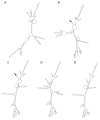Rapid fixation of a distinctive sequence motif in the 3' noncoding region of the clade of West Nile virus invading North America
- PMID: 17587514
- PMCID: PMC2268991
- DOI: 10.1016/j.gene.2007.05.007
Rapid fixation of a distinctive sequence motif in the 3' noncoding region of the clade of West Nile virus invading North America
Abstract
Phylogenetic analysis of complete genomes of West Nile virus (WNV) by a variety of methods supported the hypothesis that North American isolates of WNV constitute a monophyletic group, together with an isolate from Israel and one from Hungary. We used ancestral sequence reconstruction in order to obtain evidence for evolutionary changes that might be correlated with increased virulence in this clade (designated the N.A. clade). There was one amino acid change (I-->T at residue 356 of the NS3 protein) that occurred in the ancestor of the N.A. clade and remained conserved in all N.A. clade genomes analyzed. There were four changes in the upstream portion of the 3' noncoding region (the AT-enriched region) that occurred in the ancestor of the N.A. clade and remained conserved in all N.A. clade genomes analyzed, changes predicted to alter RNA secondary structure. The AT-enriched region showed a higher rate of substitution in the branch ancestral to the N.A. clade, relative to polymorphism, than did the remainder of the noncoding regions, synonymous sites in coding regions, or nonsynonymous sites in coding regions. The high rate of occurrence of fixed nucleotide substitutions in this region suggests that positive Darwinian selection may have acted on this portion of the 3'NCR and that these fixed changes, possibly in concert with the amino acid change in NS3, may underlie phenotypic effects associated with increased virulence in North American WNV.
Figures




Similar articles
-
Genetic and phenotypic variation of West Nile virus in New York, 2000-2003.Am J Trop Med Hyg. 2004 Oct;71(4):493-500. Am J Trop Med Hyg. 2004. PMID: 15516648
-
Evolution of new genotype of West Nile virus in North America.Emerg Infect Dis. 2011 May;17(5):785-93. doi: 10.3201/eid1705.101707. Emerg Infect Dis. 2011. PMID: 21529385 Free PMC article.
-
Genetic variation in the 3' non-coding region of dengue viruses.Virology. 2001 Mar 1;281(1):75-87. doi: 10.1006/viro.2000.0748. Virology. 2001. PMID: 11222098
-
The Spread of the Mosquito-Transmitted West Nile Virus in North America and Europe.Microb Biotechnol. 2025 Mar;18(3):e70120. doi: 10.1111/1751-7915.70120. Microb Biotechnol. 2025. PMID: 40035176 Free PMC article. Review.
-
Molecular epidemiology and evolution of West Nile virus in North America.Int J Environ Res Public Health. 2013 Oct 16;10(10):5111-29. doi: 10.3390/ijerph10105111. Int J Environ Res Public Health. 2013. PMID: 24135819 Free PMC article. Review.
Cited by
-
The evolutionary biology of poxviruses.Infect Genet Evol. 2010 Jan;10(1):50-9. doi: 10.1016/j.meegid.2009.10.001. Epub 2009 Oct 13. Infect Genet Evol. 2010. PMID: 19833230 Free PMC article. Review.
-
Correlation of Regulatory T Cell Numbers with Disease Tolerance upon Virus Infection.Immunohorizons. 2021 Apr 23;5(4):157-169. doi: 10.4049/immunohorizons.2100009. Immunohorizons. 2021. PMID: 33893179 Free PMC article.
-
Genetic variability of West Nile virus in US blood donors, 2002-2005.Emerg Infect Dis. 2008 Mar;14(3):436-44. doi: 10.3201/eid1403.070463. Emerg Infect Dis. 2008. PMID: 18325259 Free PMC article.
-
Genetic analysis of West Nile virus isolates from an outbreak in Idaho, United States, 2006-2007.Int J Environ Res Public Health. 2013 Sep 23;10(9):4486-506. doi: 10.3390/ijerph10094486. Int J Environ Res Public Health. 2013. PMID: 24065039 Free PMC article.
References
-
- Bertolotti L, Kitron U, Goldberg TL. Diversity and evolution of West Nile virus in Illinois and The United States, 2002–2005. Virology. 2006;360:143–149. - PubMed
-
- Brinton MA. The molecular biology of West Nile virus: a new invader of the Western Hemisphere. Annu Rev Microbiol. 2002;56:371–402. - PubMed
Publication types
MeSH terms
Substances
Grants and funding
LinkOut - more resources
Full Text Sources

